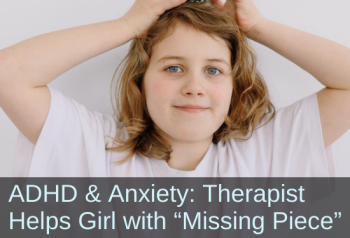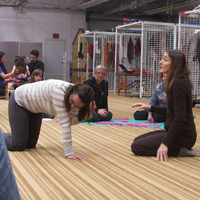10-Yr-Old Girl with Anxiety and ADHD: Gains Calm, Confidence, and Focus
Submitted by LW, OTR/L

|
Before
|
After
|
|
Struggled with self-regulation
|
Better regulated, and better able to focus on other therapeutic activities
|
|
Struggled with falling asleep at night due to being afraid of being separated from her parents
|
Improved sleep
|
|
Poor self-confidence
|
Mom reports seeing improved confidence
|
|
Anxious
|
Less anxious about little things; less fidgety
|
HH is a 10-year-old female diagnosed with ADHD and anxiety. She was referred to occupational therapy to address self-regulation, coping skills, coordination and motor planning, and executive functioning. HH was very impulsive, was unable to keep her room and school supplies organized, struggled with doing her homework, and had poor self-esteem. She was recently diagnosed with dyslexia. She struggled with falling asleep at night due to being afraid of being separated from her parents and would often sneak and hide food in her bedroom during the night. She struggled with making and keeping friends at school and had a history of being quick to react when she got upset or felt threatened.
Tools Chosen, Rationale, and Client Responses:
- I introduced HH to rhythmic movements (RMs) [From the Brain and Sensory Foundations course] for several weeks before looking at reflexes. I chose to use RMs as a way to stimulate the brainstem and cerebellum, as well as to address timing, rhythm, coordination, and self-regulation. HH initially responded by saying the movements felt “weird,” but as we continued to do them over the next 4 weeks, I noticed that she seemed more at ease, willing to participate, more regulated, and better able to focus on other therapeutic activities. HH struggled with doing active RMs and there was some tension in the upper body with passive RMs when we first started. After several weeks of doing RMs in therapy and as she was better able to do active RMs, HH reported that she was using RMs at night when she started to feel anxious and when she felt the urge to go get food in the middle of the night. She reported improved sleep as well.
- For 4 weeks we started and ended each session with the two-minute brain tune-up [From the Brain and Sensory Foundations course]. I found that this was beneficial in building a routine in therapy and it was also a way for me to observe progress with her balance and coordination. When we first started, HH moved quickly when doing cross crawls and struggled when asked to slow down. This indicated to me that she was compensating and that there were underlying issues such as unintegrated reflexes. She is still improving in her ability to do cross crawls and actually enjoys counting to see how many she can do with her eyes open and closed.
- I initially suspected unintegrated reflexes in HH due to my observations of her body movement when doing RMs, her sitting posture at the table, poor bilateral coordination, and some of her fears and anxiety. Reflex stimulation revealed a positive (unintegrated)TLR, ATNR, STNR, FPR, Moro, and spinal galant. Poor head righting with eyes closed was also noted.
- We used a therapy ball to address head righting with initial guarding and planting of her feet on the ground for stability each time the ball moved. Overall, I used a combination of developmental movements, RMs, isometrics, games, core activation activities, and support repatterning sequences [From the Brain and Sensory Foundations course] when addressing the reflexes.
- I noticed that HH’s confidence and eagerness to participate in these activities increased each session and she even requested to do some of the activities from previous sessions. Since we started focusing on these reflexes in therapy, HH’s mom reported that HH’s confidence has improved, she is more willing to try new things, and she does not seem as anxious about little things. Sleep has improved and her willingness to do her homework and complete chores has improved. In therapy, I have seen an increase in core strength as evidenced by ability to maintain supine flexion and prone extension for longer periods of time, as well as improved posture. HH also seems to be “more comfortable” in her own body and does not seem as fidgety as she was before we started these activities.
- When doing a 5-step balance [From the Brain and Sensory Foundations course] with HH, she identified wanting to learn a secret handshake as a goal. We came up with a 3-part handshake and determined that crossing midline with her hands to touch my hands was where she struggled. We used the goal “I am crisscrossing my hands” as her goal/intention. I had HH close her eyes and picture herself doing the secret handshake with someone and then had her physically act it out. Next, I had HH do some ATNR integration activities [From the Brain and Sensory Foundations course] including RMs, belly crawling games, and alternating her hands when bouncing a balloon in the air. . . I had HH state her goal again, act it out, and then we practiced the handshake. After several trials and with verbal cues to move slowly between steps, she successfully did her secret handshake and was happy.
When I first started practicing OT 28 years ago, I was taught that retained reflexes could not be changed. It has always been a topic I’ve been interested in and now that I have taken this course, I feel that this is the missing piece in so many of the children I have had the pleasure to work with. They really are the foundation for movement and impact all function. Thank you for teaching this course and sharing your knowledge.
(Edited, emphasis added)


